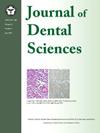牙周骨内缺损再生后的即刻正畸治疗:长期回顾性研究
IF 3.4
3区 医学
Q1 DENTISTRY, ORAL SURGERY & MEDICINE
引用次数: 0
摘要
本文章由计算机程序翻译,如有差异,请以英文原文为准。
Immediate orthodontic treatment after regeneration of periodontal intrabony defects: A long-term retrospective study
Background/purpose
Orthodontic movement is often necessary for periodontally compromised patients to enhance esthetics, function, and long-term occlusal stability. However, the impact of orthodontic treatment immediately following the regeneration of intrabony defects on periodontal healing remains a topic of debate. The objective of this long-term case series study was to test the hypothesis that orthodontic treatment performed immediately after regenerative procedures for periodontal intrabony defects did not adversely affect periodontal healing.
Materials and methods
This case series study involved nine periodontally compromised subjects with a total of 17 intra-bony defects. Orthodontic brackets were applied immediately before surgery. Flaps were raised, and diseased roots were debrided. All intra-bony defects were filled with alloplastic bone grafts and covered with resorbable membranes, except for one defect treated with Emdogain. All patients initiated orthodontic treatment immediately after periodontal regenerative surgery. Clinical parameters, including probing depth, attachment level, and bone fill, were assessed at baseline and during final maintenance therapy.
Results
The mean follow-up duration was 12.8 years. None of the 17 surgically regenerated teeth were lost. The mean reduction in probing depth was 3.94 mm (95% confidence level, 3.19–4.68; P < 0.001), with a mean clinical attachment gain of 3.47 mm (95% confidence level, 2.90–4.03; P < 0.001). The mean radiographic bone fill was 4.89 mm (P < 0.001).
Conclusion
Based on the findings of this long-term case study, it can be concluded that immediate orthodontic treatment does not adversely affect the maturation process of periodontal regeneration outcomes and can be maintained for more than ten years.
求助全文
通过发布文献求助,成功后即可免费获取论文全文。
去求助
来源期刊

Journal of Dental Sciences
医学-牙科与口腔外科
CiteScore
5.10
自引率
14.30%
发文量
348
审稿时长
6 days
期刊介绍:
he Journal of Dental Sciences (JDS), published quarterly, is the official and open access publication of the Association for Dental Sciences of the Republic of China (ADS-ROC). The precedent journal of the JDS is the Chinese Dental Journal (CDJ) which had already been covered by MEDLINE in 1988. As the CDJ continued to prove its importance in the region, the ADS-ROC decided to move to the international community by publishing an English journal. Hence, the birth of the JDS in 2006. The JDS is indexed in the SCI Expanded since 2008. It is also indexed in Scopus, and EMCare, ScienceDirect, SIIC Data Bases.
The topics covered by the JDS include all fields of basic and clinical dentistry. Some manuscripts focusing on the study of certain endemic diseases such as dental caries and periodontal diseases in particular regions of any country as well as oral pre-cancers, oral cancers, and oral submucous fibrosis related to betel nut chewing habit are also considered for publication. Besides, the JDS also publishes articles about the efficacy of a new treatment modality on oral verrucous hyperplasia or early oral squamous cell carcinoma.
 求助内容:
求助内容: 应助结果提醒方式:
应助结果提醒方式:


